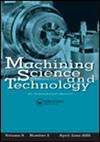多齿锯切几何参数和刀型对板材复合材料切割的影响:有限元研究
IF 2.6
4区 工程技术
Q2 ENGINEERING, MANUFACTURING
引用次数: 0
摘要
摘要短玻璃纤维复合材料,特别是片状模压复合材料(SMC),在当代航空航天、汽车和电子等领域的应用日益重要。对于这些制造业来说,SMC复合材料的加工质量仍然是一个具有挑战性的目标。本文提出了一种新的刀具设计,在钻取复合材料时,齿间有偏移,可以最大限度地减少摩擦,限制损伤,促进切屑的去除。研究了刀具几何参数,特别是刀具前角、切削倾角和互补侧切削刃角对材料去除过程以及切削力和推力的影响。利用ABAQUS / Explicit程序建立了具有代表性的多齿刀具的三维有限元模型。结果表明,对刀具几何参数进行微调可降低切削损伤,促进切削屑的去除和流动演化。前倾角对切削力和推力有显著影响。然而,这两种力对倾角不敏感。互补侧切削刃角只影响推力。所提出的结果不仅对切削过程有深入的了解,而且还提高了SMC的可加工性。本文章由计算机程序翻译,如有差异,请以英文原文为准。
Effect of geometrical parameters and tool pattern of multi-tooth sawing on cutting of sheet molding compound composite: FE study
Abstract Short glass fiber composites, particularly sheet molding compound (SMC) materials, are becoming increasingly important alternative in various contemporary aerospace, automotive, and electronic applications. For these manufacturing industries, the quality of the machined SMC composite is still a challenging target. The article proposes a new tool design with an offset between teeth to minimize friction, limit damage and promote chip removal when drilling composite materials. The effects of the tool’s geometric parameters, especially the rake, the inclination and the complementary side cutting edge angles on the material removal process, as well as the cutting and thrust forces, are investigated. A 3D finite element model of a representative multi-tooth tool is developed using the ABAQUS\Explicit code. The results show that fine-tuning the geometric parameters of the tool reduces the induced machining damage and enhances the chip removal and the flow evolution. The rake angle has a significant influence on the cutting and thrust forces. However, both forces are insensitive to the inclination angle. The complementary side cutting edge angle influences only the thrust force. The presented outcomes not only give insights into the cutting process, but also improve the SMC machinability.
求助全文
通过发布文献求助,成功后即可免费获取论文全文。
去求助
来源期刊

Machining Science and Technology
工程技术-材料科学:综合
CiteScore
5.70
自引率
3.70%
发文量
18
审稿时长
6 months
期刊介绍:
Machining Science and Technology publishes original scientific and technical papers and review articles on topics related to traditional and nontraditional machining processes performed on all materials—metals and advanced alloys, polymers, ceramics, composites, and biomaterials.
Topics covered include:
-machining performance of all materials, including lightweight materials-
coated and special cutting tools: design and machining performance evaluation-
predictive models for machining performance and optimization, including machining dynamics-
measurement and analysis of machined surfaces-
sustainable machining: dry, near-dry, or Minimum Quantity Lubrication (MQL) and cryogenic machining processes
precision and micro/nano machining-
design and implementation of in-process sensors for monitoring and control of machining performance-
surface integrity in machining processes, including detection and characterization of machining damage-
new and advanced abrasive machining processes: design and performance analysis-
cutting fluids and special coolants/lubricants-
nontraditional and hybrid machining processes, including EDM, ECM, laser and plasma-assisted machining, waterjet and abrasive waterjet machining
 求助内容:
求助内容: 应助结果提醒方式:
应助结果提醒方式:


